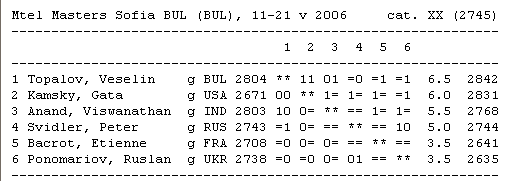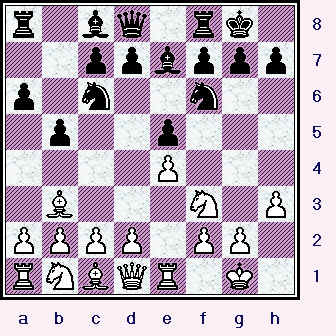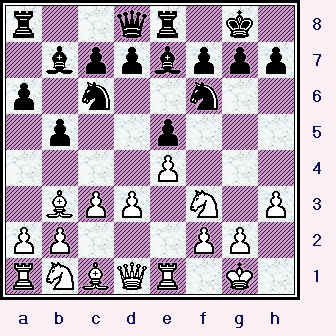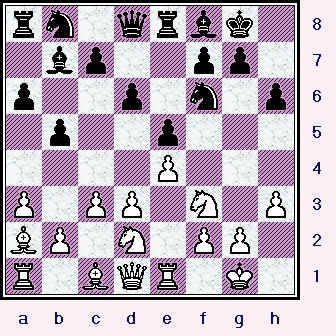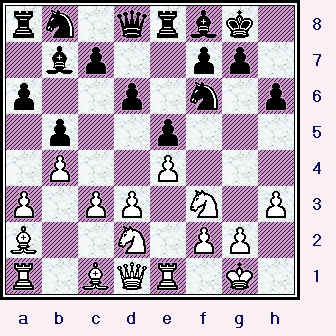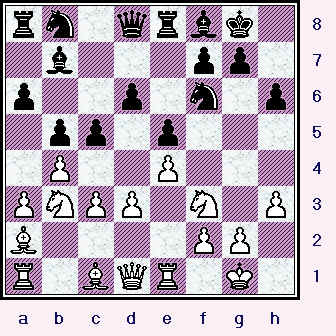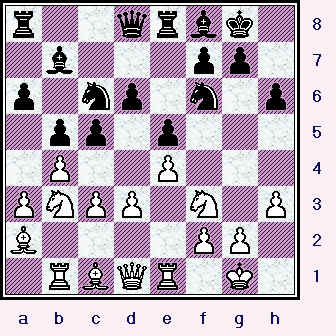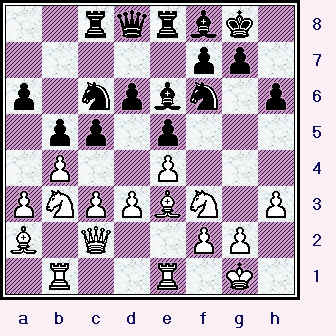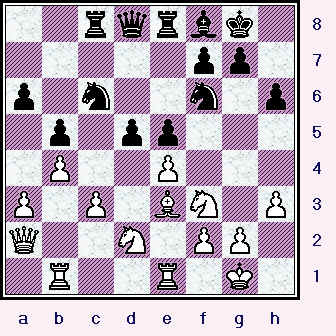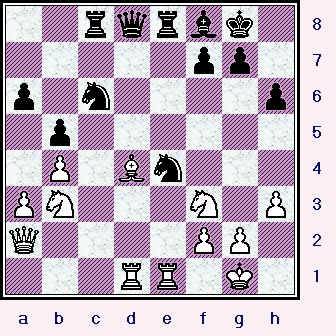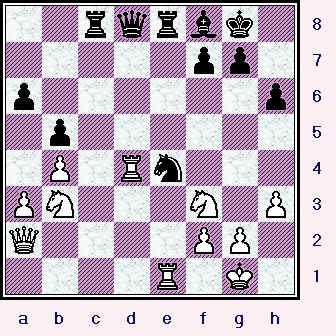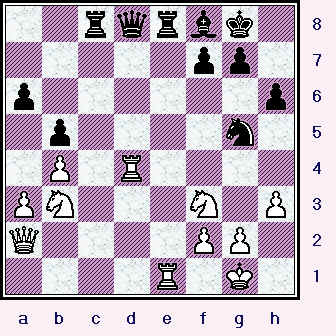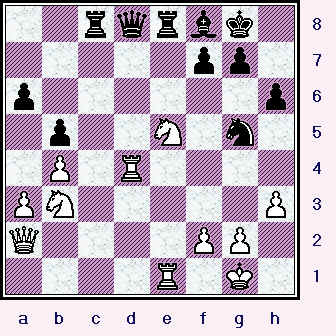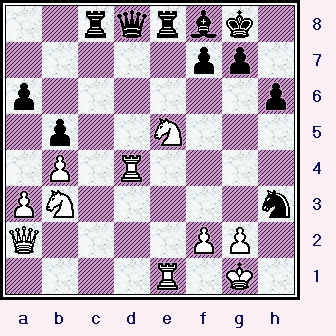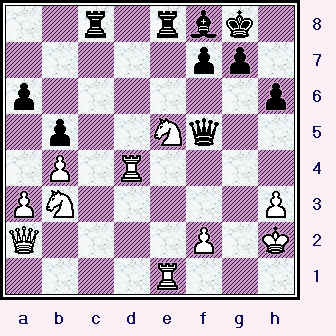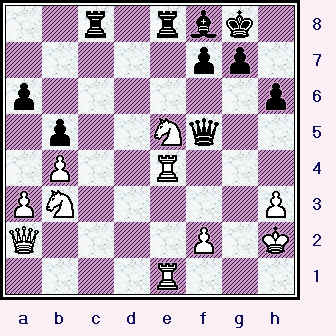GM
Veselin Topalov (2804) - GM Viswanathan Anand
(2803)
[C88]
ICT, 2nd M-Tel Masters
Sofia, BUL;
(R2) / 12,05,2006.
[A.J. Goldsby I]
Is
this one of Anand's greatest games? (I
think it could be.)
My "Game of The Month" for the period
for May, 2006. (Refer to TWIC #
601.)
Anand plays this game in a manner
that is reminiscent of the great masters, (Alekhine); releasing one truly wild
and unbelievable shot after the other. Modus operandi? Magnifico!
In March of 2006, we explored the
anti-Marshall systems with 8.a4. In this column, we will analyze the other main branch of the "Anti-Marshall" lines ... those that begin with the try, 8.h3.
I took this game to our local chess club. We reviewed this outstanding contest (more than once),
...
and I find this process highly beneficial. (To get feedback - from a great number of players of all different rating strengths - assists
me in preparing my annotations. I get a better feel for what moves the average player looks for, and what moves appear as a revelation.)
*** *** *** *** *** *** *** *** *** ***
*** *** *** *** *** *** *** *** *** ***
*** *** *** *** ***
{The ratings are accurate FIDE ratings, and were assigned to this game when it was downloaded off the Internet.}
1.e4 e5; 2.Nf3 Nc6;
3.Bb5,
After a period when QP openings seemed to rule, the Ruy Lopez is now back in style ...
there is no lack of Spanish Games in the recent issues of the Informant.
Many beginner's interpret the Ruy in the wrong manner. One of the keys to this opening is that Bb5 is chiefly a strategical play. (The first player offers a possible pin, and undermines Black's main center support. Bb5 here also enables rapid development, already White is ready to castle, and it is only move three.)
It is because of these deep positional elements that the first player can usually wind up dominating the center.
[ For a good example of the move
3.Bc4!?,
see the following
game:
GM S. Kudrin - GM A.
Onischuk; /
U.S. Championship, 2006. ]
3...a6;
The Morphy Defense, most masters consider this Black's most flexible continuation, as the second party has the greatest number of solid opening choices.
[ The "Berlin Wall"
(Berlin Defense) is reached after the moves:
3...Nf6;
4.0-0 Nxe4; 5.d4 Nd6; 6.Bxc6 dxc6; 7.dxe5
Nf5; 8.Qxd8+ Kxd8;
and although Black's position looks bad, the second player's position turns
out to be surprisingly elastic. (Many top players - like Garry Kasparov - have
been unable to dismantle the second player's defensive fortress.)
A recent example would be:
GM L.D. Nisipeanu - GM V.
Topalov; /
First Match Game, (Game # 1)
Bucharest, ROM;
2006. {1/2, 25 moves.}
Black was never in any trouble and drew the game without real difficulties.
]
Both sides continue to develop.
4.Ba4 Nf6; 5.0-0 Be7;
This leads to the closed defence. (The center remains static or blocked.)
[ After the following moves:
5...Nxe4;
6.d4 b5;
7.Bb3 d5; 8.dxe5 Be6; 9.c3,
"+/="
we reach the Open
Defence. (Key center pawns have
been exchanged off here, thus the center is more open -
as compared to the main lines of the Ruy Lopez.)
A recent example would be:
GM A. Grischuk (2719) - GM E. Sutovsky (2628);
[C83]
XIII
TCh-RUS /
Sochi, RUS; (R7) / 26,04,2006.
{White won a marvelous contest thirty-seven total moves.} ]
6.Re1 b5;
7.Bb3 0-0; 8.h3, (Anti-Marshall)
{See the
diagram given - just below here.}
8.a4 is one way of declining the gambit offered by Black, this is another way of meeting the tricky line
...
that was created by Marshall.
r1bq1rk1/2ppbppp/p1n2n2/1p2p3/4P3/1B3N1P/PPPP1PP1/RNBQR1K1 b
One of the benefits of this move is that (after 8.h3) play can often transpose back into normal channels.
This try - seems to be very popular as of late, we went over three or four such games, (with this particular 8.h3 line); at chess club one Sunday. (I will often print out the games from latest issues of TWIC and take them to chess club with me.)
[ For a thorough investigation of the move:
8.a4,
please see my March (2006) column.
{An analysis of: GM P. Leko - GM L.
Aronian; Linares, 2006.}
]
8...Bb7;
This is the most topical way of meeting h3, it is also the strongest.
(Black puts immediate pressure on White's KP.)
[ After the simple moves:
8...d6; 9.c3,
"+/=" play will return {transpose}
to
the normal channels of the Ruy Lopez.
]
Now both sides slowly improve their positions (from move nine until White's 12th move) ...
with dominating the center being the ultimate goal.
9.d3 Re8;
A very solid move, there certainly cannot be anything wrong with bringing a Rook to a central file, especially not here.
The "book" move here is 9...d6; but obviously many of these lines can simply transpose to the other.
[ A popular reference work gives:
9...d6; ('!?')
10.a3,
A common move here ...
but it is far from being the only playable move for White.
*** *** *** ***
*** *** *** ***
*** *** *** ***
*** *** *** ***
*** *** *** ***
*** *** *** ***
*** *** *** ***
( White has also played 10.a4 quite a bit in this position.
A very recent example would be:
10.a4 Na5; 11.Ba2 c5;
12.Nbd2 Nd7; Unusual ... (TN?)
(12...b4; and 12...Bc8 have both been played before.)
13.Nf1 Nb6;
14.Bd2 b4;
15.c3 bxc3; 16.Bxc3 Nc6;
17.a5 Nc8!?; 18.Ne3, "+/="
White had a small edge, and eventually won this contest.
GM Veselin Topalov (2804) - GM Ruslan Ponomariov (2738);
ICT, M-Tel Masters {Inv.} (1-0) /
Sofia, BUL; (R8)
/ 19,05,2006.
{White won a very tough battle in sixty-five total moves, the
analysis of this game
continues to hold me in thrall.} )
*** *** *** ***
*** *** *** ***
*** *** *** ***
*** *** *** ***
*** *** *** ***
*** *** *** ***
*** *** *** ***
10...Nb8!;
(Re-deploy.)
I like this line best for Black, it seems to offer Black the best practical chances.
*****************************************************************************************************************
*****************************************************************************************************************
a).
In the same tournament as this game, we saw the continuation:
10...Qd7; 11.Nbd2 Nd8!?;
Black transfers his Knight over to the Kingside - in a manner that is
normally reserved for the player on the White side of the chess board.
*** *** *** ***
*** *** *** ***
*** *** *** ***
*** *** *** ***
*** *** *** ***
*** *** *** ***
*** *** *** ***
( Another interesting contest was the following: 11...Rae8!?;
12.c3 d5;
13.a4 dxe4; 14.Nxe4 Rd8; 15.axb5 axb5; 16.Ng3,
"+/=" 16...h6;
White has (maybe) a slight edge, but I consider Black's position to
be more than playable.
GM Viktor Bologan (2661) - GM Ruslan Ponomariov (2723);
ICT, 7th Karpov (Inv, 1-0) /
Poikovsky, RUS; (R5)
22,03,2006.
{White won
a long, weird and rather difficult struggle.}
Cf. The Week in Chess #594,
(63 moves).
)
*** *** *** *** *** *** ***
*** *** *** *** *** *** *** *** *** *** ***
*** *** *** *** *** *** *** *** *** ***
12.c3 Ne6; 13.d4 Rad8!?;
14.d5 Nf4; 15.Nf1 Ng6; 16.Ng3,
"+/=" (space)
with a slight edge for White.
GM Viswanathan Anand (2803) - GM Gata Kamsky (2671); [C88]
ICT, M-Tel Masters, (0-1, 57
moves.) /
Sofia, BUL; (R3) / 13,05,2006.
{Black won a wonderful
game, a grand total of 57 moves. This was a very
fine R+P endgame, if I can find the time, I want to make a web page out of it.}
**************************************************************************************************
b).
In the same event, we also saw:
10...Na5!?; 11.Ba2 c5; 12.Nc3, "+/="
12...Nc6; 13.Rb1!?
N
13...Rc8!?;
Placing the Knight on d4 was a serious consideration. In some lines, the
computer shows that Black plays for the ...d6-d5 Pawn break. In that case,
Black's QR might be better off on d8.
14.Bd2 Nd4; 15.b4!? Nxf3+?!;
(Maybe - '?')
The simple move of
>/= 15...Qc7; gave Black a great game.
16.Qxf3 c4?!;
(>/= 16...Rc7) 17.dxc4
bxc4; 18.Qe2,
"+/="
White had a fairly large edge, and may have blown a win in the R+P endgame.
{White WON in
over 100 moves!!! A real Super-GM marathon! And to be fair,
it looked
like Black was nearly winning at one point, but lost his way and
earned a zero
on the cross-table}
GM Gata Kamsky (2671) - GM Etienne Bacrot (2708);
[C88]
ICT, M-Tel Masters,
(1-0, 103
moves.) Sofia,
BUL; (R2) /
12,05,2006.
{The same round as our main game for this month!}
*****************************************************************************************************************
*****************************************************************************************************************
11.Nbd2
Nbd7; 12.Nf1 c5!?;
(Thematic, but is it correct here?)
Right now, the play (and positions) are very similar to those of the actual game here.
*** *** *** ***
*** *** *** ***
*** *** *** ***
*** *** *** ***
*** *** *** ***
*** *** *** ***
*** *** *** ***
( Instead, after the moves:
12...Re8; 13.Ba2 c6;
14.Ng3 Bf8; 15.Nf5 d5;
16.d4 c5; 17.dxc5 Nxc5;
18.exd5 e4; "~" (Maybe "=")
with a rich position - that has equal chances for both sides.
GM Garry Kasparov (2847) - GM Vladimir Kramnik (2807);
XX (#20) Super-GM (1/2) // Linares, ESP; (R8) / 22,02,2003.
{Eventually drawn
in 33 moves.} )
*** *** *** ***
*** *** *** ***
*** *** *** ***
*** *** *** ***
*** *** *** ***
*** *** *** ***
*** *** *** ***
13.Ng3
Rc8; 14.Qe2 Qc7!?; 15.Nf5 Bd8!?; 16.Bg5
c4; The end of the column.
17.Ba2
Re8; 18.Rad1 d5!?; Interesting.
( The try of (>/=)
18...Nc5;
"~" looks OK for Black. )
19.exd5
Bxd5; 20.dxc4 bxc4; 21.Bxf6 Nxf6; 22.Nxe5, "+/="
22...g6;
... "with fair play for a Pawn."
- W. Korn and GM Nick de Firmian.
GM A. Shirov - GM I.
Sokolov; /
ICT, Koop Tjuchem (Round # 10)
Groningen,
NED; 1996.
(1-0)
{White won ... but it took well over 100 moves in all!}
[ See MCO-14, page # 91; column # 41, and now especially note # (u.) here. ]
]
10.c3, {See the diagram below.}
I like this move, White plays for the center, and prepares the maneuver of Nbd2-f1-g3, which is a normal part of the motifs which White uses in this particular opening system.
r2qr1k1/1bppbppp/p1n2n2/1p2p3/4P3/1BPP1N1P/PP3PP1/RNBQR1K1 b
White also has many other moves here as well. (Like 10. a3, 10. a4, 10.Nc3, 10.Nbd2, etc.)
See any good book (on this variation) ... or ECO ... for more details on this line.
[
10.Nc3 h6;
('!?')
This is probably Black's most solid option, and is the one that top-level players use
the most often here, (according to statistics generated from the database).
*** *** *** *** *** *** *** ***
*** *** *** *** *** *** *** ***
*** *** *** *** *** *** *** ***
*** *** *** ***
(Black can also try the sharp:
10...Bb4!?;
11.a3 Bxc3;
12.bxc3 Na5; 13.Bg5 h6; 14.Bh4,
"+/=" 14...c5;
as in the contest:
GM R. Kasimdzhanov (2670) - GM Vishy Anand (2792); /
Bundesliga 2005-6 /
Baden Baden, GER; (R#14) /
01,04,2006. (0-1, 31 moves.)
White is probably slightly better in this position, but Black had good play,
and went on to win a sharp fight in only 31 moves.)
*** *** *** ***
*** *** *** ***
*** *** *** ***
*** *** *** ***
*** *** *** ***
*** *** *** ***
*** *** *** ***
11.a3 d6;
12.Ba2, "+/=" 12...Bf8;
Fritz confirms that White is solidly (a little) better in this position, although Black's position
is considered to be quite playable.
The best, (recent); example of this position would probably be:
GM Mohamad Al Modiahki
(2579) - GM Zurab Sturua
(2533);
ICT, Sixth Masters Open, /
Dubai, UAE; (R#9)
/ 19,04,2004.
{White won a nice game in just under sixty tough moves.}
]
10...h6;
11.Nbd2 Bf8;
12.a3,
White plays this move because he wishes maintain his KB on the a2-g8 diagonal. (Compare this to Nf1, Na5; and now White must allow the Bishop to be exchanged off or retreat it to the {somewhat passive?} c2-square.)
12...d6;
13.Ba2!?,
Now Topalov begins playing a whole series of "prophylactic moves," that may not be really all that useful.
[ Possibly better would have been the following continuation:
(>/=) 13.Nf1 Na5; 14.Ba2 c5!?;
15.b4! Nc6; 16.Ng3, "+/="
when White holds a small, (but fairly solid); edge.
] 13...Nb8!;
(Go home.) {See
the diagram, just below.}
A useful redistribution of Black's forces, Anand's use of this move here reminds one of the variations of the Breyer Defense. (The
Breyer = 1.e4 e5; 2.Nf3 Nc6; 3.Bb5 a6; 4.Ba4 Nf6; 5.0-0 Be7; 6.Re1 b5; 7.Bb3 d6; 8.c3 0-0; 9.h3 Nb8; etc.)
rn1qrbk1/1bp2pp1/p2p1n1p/1p2p3/4P3/P1PP1N1P/BP1N1PP1/R1BQR1K1 w
The main points of this move are:
# 1.) The Black Knight is usually "re-developed" to the d7-square, a slightly more flexible and useful post.
# 2.) Black's QB has been unmasked.
# 3.) The Black Knight can support its brother on f6 and even can be brought over to the King-side for a
defense against a possible sustained assault by his opponent.
# 4.) Black is free to play ...c7-c5. This pawn advance does many useful things, notably gaining some
space and attacking the center.
[ Fritz likes:
13...Qd7;
here. This move also gives Black a very comfortable game. ] 14.b4!?,
(TN?) {See
the diagram given, just below.}
A fairly standard Ruy maneuver, the point is to gain a little space, take a few squares away from his opponent, (Now Black cannot play ...Nc5.); and perhaps discourage Black from playing ...c7-c5; as well.
rn1qrbk1/1bp2pp1/p2p1n1p/1p2p3/1P2P3/P1PP1N1P/B2N1PP1/R1BQR1K1 b
Two other options were:
A.) 14.Nf1-g3, a standard maneuver for these types of Lopez positions.
B.) 14.Nh4, aiming for the f5-square. (See the note just below.)
As far as I was able to determine, this move, (14.b4); is new to master-level practice.
(I made a db with all the games that I could find after h3, Bb7; to be sure of my findings.)
[ White could also play:
14.Nh4
d5; 15.Qf3 c6;
( </= 15...Nxe4?!; 16.Rxe4!!, "+/=")
16.b4, "+/=" (space)
The first party had slightly the better game, although this particular contest
was
eventually drawn just past move forty.
V. Topalov (2700) -
M. Adams (2716); /
ICT, 16th Super-GM {1/2}
Linares, ESP;
(R#2) / 21,02,1999.
]
14...c5;
15.Nb3!?, hmmm
{See the
diagram given, just below.}
Truly an ugly move ... the comments of a few of the titled players who were observing this game (on-line, as it being played) were hilarious to read.
rn1qrbk1/1b3pp1/p2p1n1p/1pp1p3/1P2P3/PNPP1N1P/B4PP1/R1BQR1K1 b
One commentator said that someone must have "slipped Topalov a mickey." (An on-line columnist said that White's tea
had been drugged, but I am sure he was speaking facetiously.) We replayed this game at chess club - just a day or so after it was played.
I told several of the players there that it appeared that Veselin Topalov had begun to play like a "Class C" player, just randomly moving his pieces about and playing totally without a plan.
Just about any move had to be better than this. Two obvious suggestions: are
>/= 15.b4xc5, which is what Fritz likes; or - >/= 15.Nf1, (again) with the idea of Ng3-f5, which is a standard Ruy Lopez type of maneuver.
[ Maybe just
>/= 15.Bb2,
"=" was better than what Topalov actually played.
]
15...Nc6!;
This is even better (here) than the {anticipated move} idea of playing the Knight to the d7-square.
16.Rb1!?,
(Maybe 16.Bb2 here?)
{See the
diagram given, just below here.}
Will someone please explain to me exactly what Topalov's concept is in this position?
r2qrbk1/1b3pp1/p1np1n1p/1pp1p3/1P2P3/PNPP1N1P/B4PP1/1RBQR1K1 b
Silly me, I thought of playing something like Qc2 here. (A move which Fritz also favors.)
16...Bc8;
(Maybe - '!')
Anand is already dreaming of sugar plums, magic stars ... and cruel Kingside attacks!
Now Bb2 appears to be best, but Topalov once more plays a move that I had not
(seriously) considered.
17.Be3 Be6; 18.Qc2 Rc8; "~"
("=/+")
{See the diagram given - just
below.}
Black's position is a model of ideal development and harmony among his pieces.
2rqrbk1/5pp1/p1npbn1p/1pp1p3/1P2P3/PNPPBN1P/B1Q2PP1/1R2R1K1 w
Meanwhile, Topalov's position looks as if his pieces were thrown at the chess board - randomly, with the thrower's eyes firmly closed - from across the room!!
Now Topalov plays ... yet another move! ... that I really don't like or understand.
(>/= 19.Nbd2.)
19.Qb2!? c4!; 20.dxc4 Bxc4;
This is good for Black ... as was the seemingly obvious move of 20...Nxe4.
21.Nbd2 Bxa2;
White played all of those moves to get his Bishop to a2 ... ... ...
only to see it traded of like this.
Now - weren't all of those moves pretty much a waste of time? 22.Qxa2 d5!;
{See the
diagram given, just below.}
Its (still) all about the center.
2rqrbk1/5pp1/p1n2n1p/1p1pp3/1P2P3/P1P1BN1P/Q2N1PP1/1R2R1K1 w
Now Anand's dark-squared Bishop (on f8) has finally been liberated. 23.Rbd1 d4!?;
(Maybe - '!')
This is the most forcing move, and therefore it is hard to ignore. Yet Black had several other moves at his disposal here, and nearly all of them yielded Black a small edge from this position.
[ Also possible was:
23...Re7;
"=/+" for Anand in this position. ]
24.cxd4 exd4;
25.Nb3!?,
"Still fighting for an advantage, something not surprising in Topalov's games. 25.Nxd4 would have been safer."
- GM Mikhail Marin. ("15.Nb3?!" - GM Mikhail Marin)
[ Best was:
>/= 25.Nxd4! Nxd4; 26.Nb3 Nxe4;
27.Bxd4, "~" (Maybe "=/+")
{Diag?}
with a position that might be a shade better for Black, but I doubt that its anything serious.
]
25...Nxe4;
26.Bxd4?!, {See
the diagram - just below.}
Now this appears to be an error, but strangely ... I could find no one else mentioning anything bad about this play.
(Maybe "26.Bxd4?" is the correct way that this move should be labeled here?)
2rqrbk1/5pp1/p1n4p/1p6/1P1Bn3/PN3N1P/Q4PP1/3RR1K1 b
At chess club, I had printed out the score of this game, & several of the members were going over it together. My friend, Steve Davis was holding the score, and at this point I suggested
>/= 26.Qb2[], {Box};
to exploit the pin on the d-file. (I was gratified to finally discover that Fritz showed that this this was indeed White's best move at this point.)
26...Nxd4;
27.Rxd4[], {See
the diagram - just below.}
White really had no choice here ...
taking with either Knight allows Anand a Knight fork on c3, winning the exchange.
2rqrbk1/5pp1/p6p/1p6/1P1Rn3/PN3N1P/Q4PP1/4R1K1 b
Now if Topalov had really calculated this far ahead, he seems to have done well. One {former} student, who happened to be in town visiting, thought that Black was in big trouble here. (He did not realize that the retreat of the Black Knight to d6
would have probably yielded a position with close to equal chances.)
It is Black to move here. What is the very best move for Black?
27...Ng5!!;
(decoy) {See
the diagram - just below.}
"A fantastic move, overlooked by Topalov. All of a sudden, White is in trouble." - GM M. Marin.
(The GM also awards this move two exclams here.)
2rqrbk1/5pp1/p6p/1p4n1/1P1R4/PN3N1P/Q4PP1/4R1K1 w
To me, this is a really thunderous shot, a stunner of the kind you only see once every five or ten years.
(When I saw this move at chess club, my mouth was literally left hanging agape in surprise.)
[ Less effective was:
27...Nd6;
"~" ]
28.Ne5!?, (hmmm)
{See the
diagram - just below.}
White tries the best that he can, Topalov - bless his soul - never goes quietly. (Fritz shows that White should play Qb1 or Rxe8, apparently Topalov would rather quit than to allow Anand to rip his Kingside up in such a manner.)
2rqrbk1/5pp1/p6p/1p2N1n1/1P1R4/PN5P/Q4PP1/4R1K1 b
Topalov seems to have staved off the worst of the storm at this point.
[ Simply impossible would have been:
</= 28.Rxd8? Nxf3+; 29.gxf3 Rxe1+;
30.Kg2 Rxd8; "/+"
(Maybe "-/+")
when Black has what amounts to a "win on technique" from here.
]
28...Nxh3+!!;
(Maybe - '!!!') {See
the diagram - just below.}
Another shocker, I thought Black would play 28...Qc7; with a fairly nice game. ("=/+") Instead Anand finds something MUCH better!
2rqrbk1/5pp1/p6p/1p2N3/1P1R4/PN5n/Q4PP1/4R1K1 w
From what I could gather, Anand played this move almost instantly, meaning that he had worked all of this out in advance. (Marin only gives this one exclam, and I must vehemently disagree with the respected GM about his call on this move.)
The move is really not at all obvious, one {internet} Navy student ... who is rated about 2050 said he worked on this
position for close to half an hour ... and never even seriously considered taking on h3.
29.gxh3,
(Box?)
This looks to be nearly forced, some of the alternatives are pretty horrible - and lose instantly.
[
</= 29.Kf1?! Qc7;
30.Rd7 Qb8; "/+"
] 29...Qg5+!;
Yet another surprise ... I thought that Anand was going to play his Queen to the f6-square here. 30.Kh2!?,
(hmmm) [Not the best?]
This might be dubious, but Topalov is not about to give up ... not yet, anyway.
(>/=
29.Rg4[], - Fritz 9.)
[ Instead, after the moves of:
(>/=) 30.Rg4 Rxe5!;
{D?}
This wins material, but Fritz is looking at 30...Qh5 here.
(This might be something for the curious to investigate.)
31.Rxg5 Rxe1+; 32.Kg2 hxg5;
"/+" Black is much better here.
Once again, the second player has two Rooks for the Queen -
and
probably a technically won game.
] 30...Qf5!!;
(Zwieschenzug) {See
the diagram - just below.}
It is this wonderful "in-between move" that Anand has foreseen, (and that I had overlooked); that wins the game
instantly.
(Maybe this move only deserves one exclam, but I give it two ... just for effect.)
2r1rbk1/5pp1/p6p/1p2Nq2/1P1R4/PN5P/Q4P1K/4R3 w
At this point, I was working feverishly, trying to calculate the consequences of the Black Rook taking the BN on the e5-square, completely unaware that there was something better. (One on-line kibitzer said it best: "You have to play over this game a few times before you realize the strength and impact of ...Qf5!!")
Now the threat is 31...Rc2!, winning on the spot for GM Vishy Anand.
[ Not as effective would be:
</=
30...Rxe5!?; 31.f4 Qg6!;
"/+"
but Black will come out on top.
]
31.Rde4,
(Ohhh ........ kay ........) {See
the diagram - just below.}
I guess Topalov is still trying to be tricky, or is hoping for some type of swindle.
2r1rbk1/5pp1/p6p/1p2Nq2/1P2R3/PN5P/Q4P1K/4R3 b
Now its practically a chess problem here, "Black to move and win."
[
(>/=) 31.Qd2 Rxe5;
"-/+" ]
31...Rxe5!;
32.Rxe5 Bd6;
Now this pin decides everything, the rest does not really require any comment from me.
33.Nc5 Bxe5+;
34.Kg2 Rc6!;
35.Qb3!? Rg6+; 36.Kf1 Bg3;
"-/+" White Resigns.
Its easy from here ... now Topalov's position is really falling apart, so he duly raises the white flag of surrender.
See the CB website {and this article} for GM Mikhail Marin's look at this game.
(http://www.chessbase.com/newsdetail.asp?newsid=3099)
This could well be one of Anand's greatest victories ... for me, it is a super brilliancy of the highest caliber.
(QED!!!!!)
Copyright (c) A.J. Goldsby, 2006. All rights reserved.
0 - 1
The analysis for
this page was prepared with the excellent programs,
ChessBase
8.0 and ChessBase
9.0.
The HTML was
polished with several different tools and programs, (mostly
FP) ... the text was checked for spelling with
MS Word.
The diagrams were
created with the program, Chess
Captor 2.25.
|
